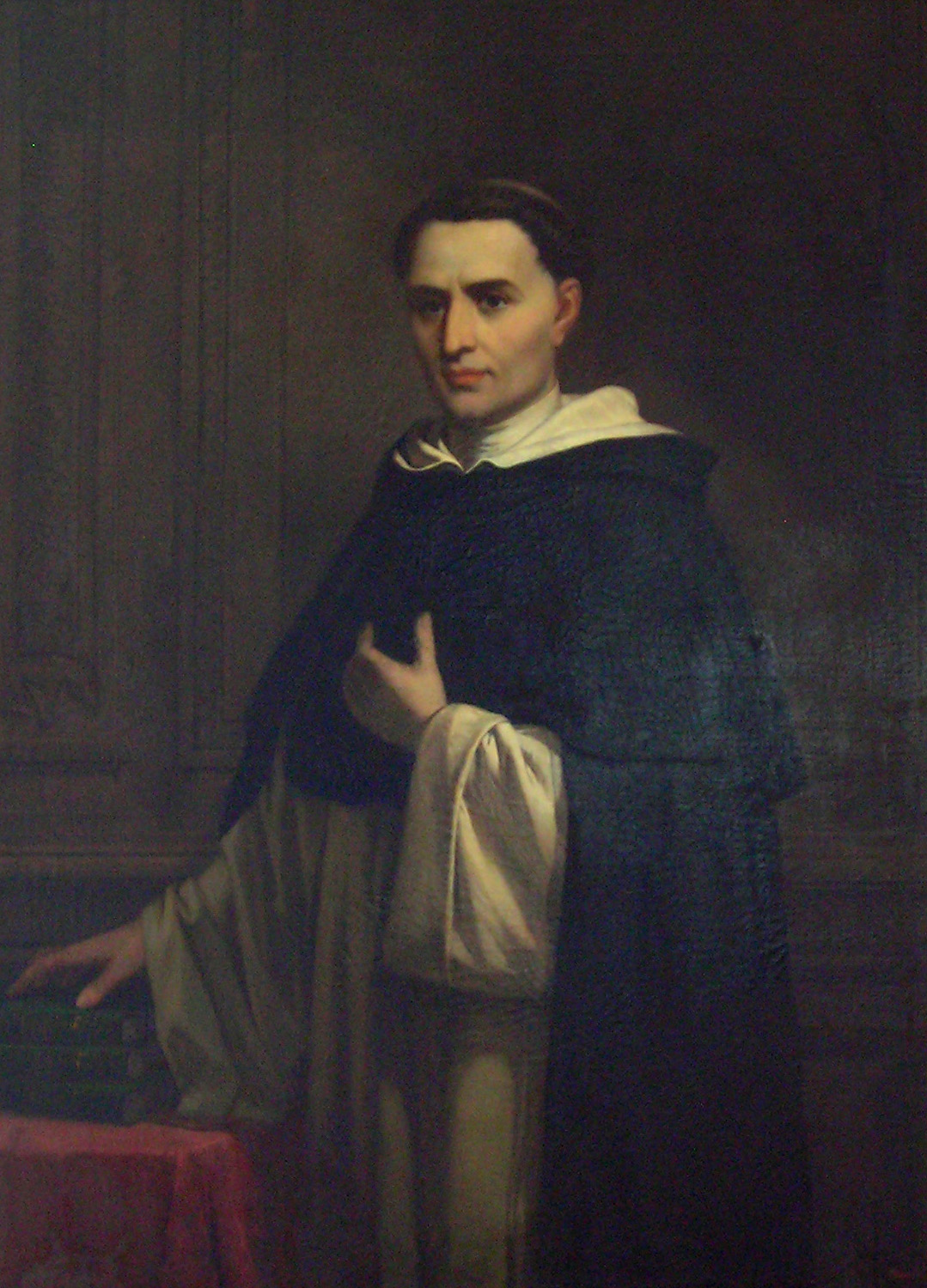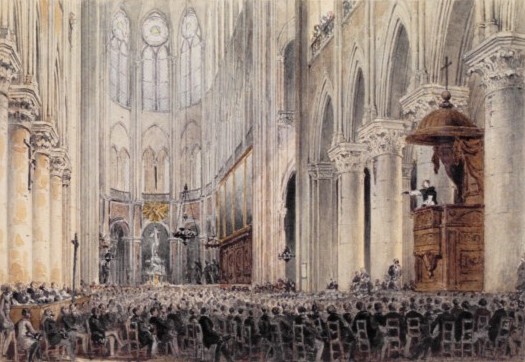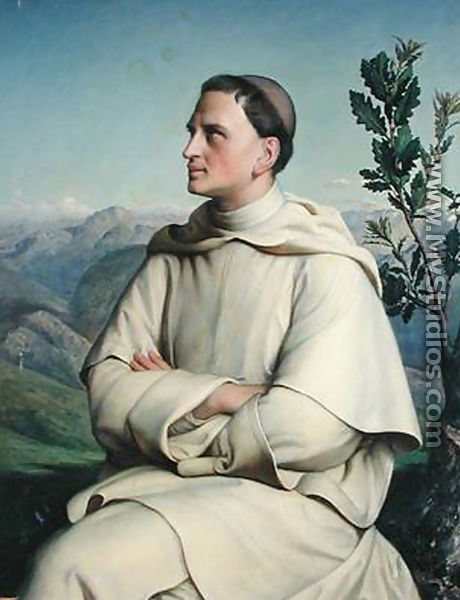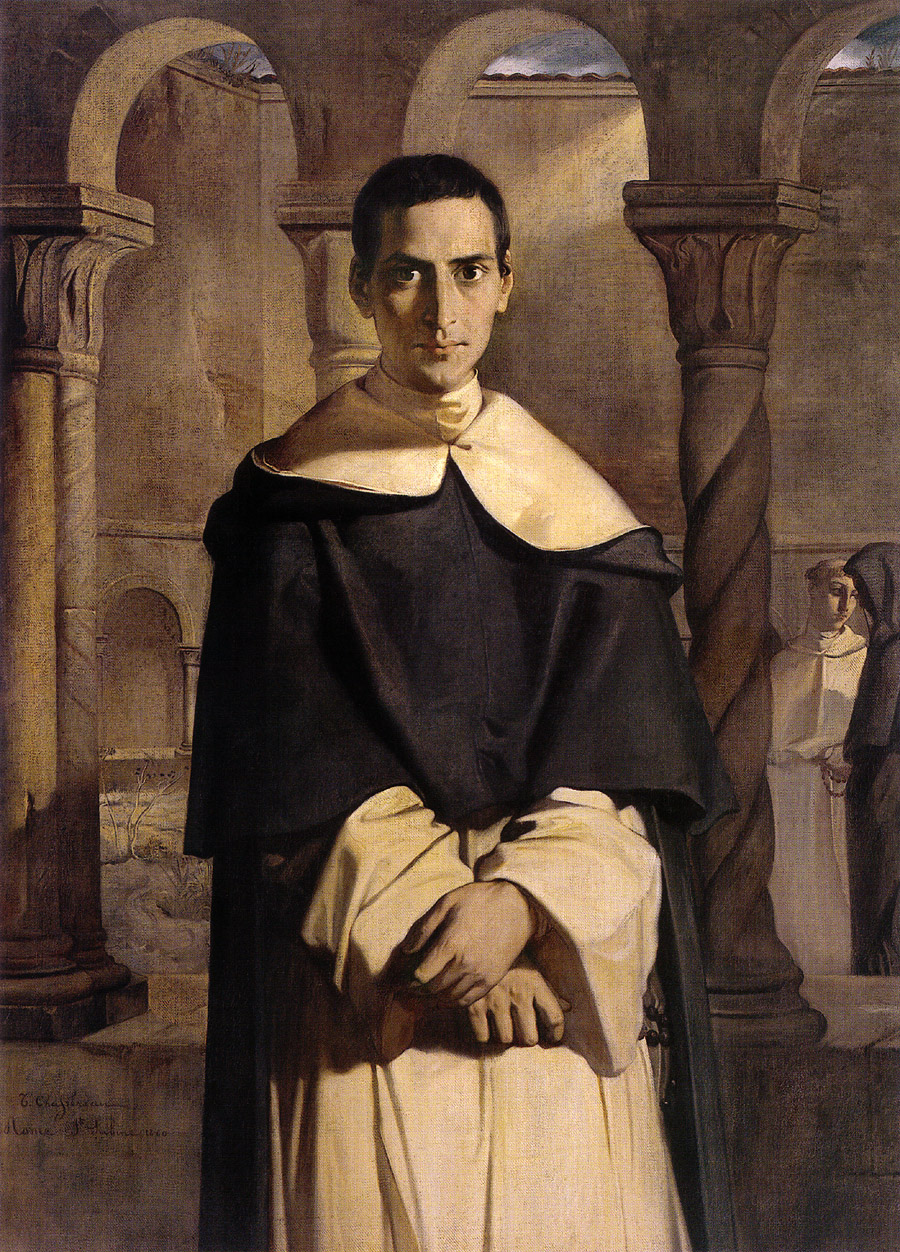
“In Book 1 of the Summa contra Gentiles, St. Thomas Aquinas discusses the mode of inquiry taken up in theological study. He distinguishes two types of truth which the theologian seeks to understand. The first is that which unaided reason can know on its own. These arguments have demonstrable proof, and demand assent from all who understand them. Arguments like these, such as the (Ed. cosmological, if you subscribe to that type) proofs for the existence of God, or that 2+2=4, can be carried out without the light of faith. The second type of truth is that which surpasses reason and is only known by faith. These truths are above our natural capacities of understanding and we rely upon God’s revelation to know them.
There can be a temptation then to believe that truth is somehow divided and separate: that there is a truth of reason and a truth of faith. These two truths propose different ideas and are accepted variously. Faith becomes opposed to reason, and thus becomes the enemy of a supposedly rational people. Only a generation before Lacordaire, the Cathedral of Notre Dame had been desecrated by the revolutionaries and turned into the “Temple of Reason.” The scene must have been striking. It represented the supposed fall of religion, having been overcome by pure and unfettered reason.
Yet, for St. Thomas, this presents us with a false dichotomy. Faith and reason are not fundamentally opposed, but rather two sources to gain true knowledge. Both come from one source, God. Truth is twofold only for us, by our manner of coming to know it. Yet truth is fundamentally one, for it has one source, God. God is the source for all truth, whether we come to know it by natural abilities or as inspired by Faith. As truth has one source, no two truths can ever contradict each other. A truth of faith can never be contradicted by a truth gained through reason, nor vice versa.
Thus, Voltaire’s critique of the unreasonableness of Christians is itself against truth. Faith elevates what we can know. St. Thomas argues further in the Summa contra Gentiles that it is most unreasonable to assert that we cannot assent to truths which are above reason. We are not the arbiters of Faith, but trust in the inner coherence of the unity of the created world. While some Christians have certainly been guilty of denying rational truths, the real task remains to show the compatibility between Faith and reason. Lacordaire presents us with an example of how this should be done.
In an age not unlike ours, where men seek first to be free, Lacordaire came proclaiming that it was only in God that one could achieve real freedom. This is attained in being released from real bondage. The world was, and remains, captive to sin. What the Incarnation brought was redemption, merited by the blood of Christ. In order to have true freedom, the dream of the Enlightened world, one first needs salvation. Lacordaire showed that only in Christ would the modern ideals, correctly understood and moderated, ever be achieved.
While apologetics as a subject might not be particularly popular today, it still has a place in Catholic theology. Lacordaire provides us an example of how this can be carried out. There are some foundational principles which we can learn from him.
First, good apologetics address the questions that people are really asking in a mode that they understand. In an age like ours, where men seek first to be free, Lacordaire came proclaiming that it was only in God that one found true freedom. It was not “a law of bondage” that some had claimed. He also used numerous external references to history, psychology, philosophy, poetry, and literature to illustrate his points to his own particular audience. A good apologist has to meet people where they are, speaking in a way they can understand, answering the questions people are asking. Dominicans seem uniquely qualified to respond to such questions. A life lived both in prayer and study, as well as in an apostolate, allowed Lacordaire to best confront the issues of his time.
Next, apologetics done rightly show that answers to life’s deepest questions can only be found in the Catholic Church. This is what we preach to a world looking for redemption. Lacordaire gave his orations with expressiveness and enthusiasm, emphasizing that values familiar to his own day and age: liberty, equality, fraternity, patriotism, self-giving, and a sense of sacrifice, could only be truly achieved within the Catholic Church. As he argued, “The Church had the words reason and liberty on her lips when the inalienable rights of the human race were threatened with shipwreck.” Finally, perform apologetics from a position of charity and humility. Nothing is more off-putting to modern man than a position of assumed authority. Again, Lacordaire: “Real excellence and humility are not incompatible one with the other, on the contrary they are twin sisters.” We have to show that we too are pursuing truth, like all people, and that we want to find it with them. The Catholic Church has provided us with answers, and we merely want to share them.”(1)
Faith, Hope, Love,
Matthew
(1) Br Constantius Sanders, OP

-Lacordaire preaching his Lenten Conferences from the elevated pulpit at Notre-Dame Cathedral, Paris, 1845.
“In Advent of 1843, Lacordaire ascended the winding steps of the pulpit at the Cathedral of Notre Dame. About eight years earlier, he had given a series of conferences there which, by all accounts, were a roaring success—reports state that they averaged over 6,000 attendees per conference. The conferences were aimed at teaching the Faith again to a country that had lost it in the Revolution. But this time was different. In 1836 Lacordaire had left France in order to further his education in Rome. While there, he had met the Dominican Order and joined their number. After formation, he returned to France with the expressed aim of restoring the Order in his home country. And did the Dominicans ever need restoring—they had gone from over 20,000 friars in 1789 to less than 5,000 a generation later. Around this time, one John Henry Newman became interested in religious life. Finding the Order much diminished in Europe, he wondered if it was not “a great idea extinct.”

-“Henri Lacordaire At Sorreze” by Anne-Francois-Louis Janmot, oil on canvas, 1847, Chateau de Versailles, Paris, France.
Yet, Lacordaire did not seek to resurrect a nearly extinct religious order simply for the novelty of it. Nor was he against the liberal egalitarian ideals of the revolutionaries. He too was a self-avowed proponent of liberté, égalité, et fraternité. It is reported that shortly before his death he told a confrere: “I die a repentant religious, but an unrepentant liberal.” Lacordaire believed that the desires for true freedom were fundamentally good, but that they could only be fulfilled in Christ. Figures like Voltaire were not the enemy, but misguided and a source for confusion. Faith did not destroy the rational capacities of the believer, but could be a source for greater insight into reality. He sought to show the modern world that Christianity was both true and in accord with what they sought.”(1)
In January 1834, at the encouragement of the young Frédéric Ozanam, the founder the Society of Saint Vincent de Paul (a charitable organization,) Father Lacordaire started a series of lectures at the Collège Stanislas. This met with great success, even beyond his students. His thematic emphasis on freedom provoked his critics, who charged him with perverting the youth. Lacordaire was reputed to be the greatest pulpit orator of the nineteenth century. Lacordaire’s preaching was not so much penitential as an exercise in apologetics. He demonstrated that one could be a French citizen and a Catholic. The lectures were a great success.
Monseigneur de Quélen, the Archbishop of Paris, asked Lacordaire to preach a Lenten series in 1835 at the Cathedral of Notre-Dame in Paris, as part of the Notre-Dame Lectures specially aimed at the catechesis of Christian youth, which had been inaugurated at the behest of his friend Ozanam. Lacordaire’s first lecture took place on 8 March 1835, and was met with wide acclaim. The social event of its day, 6,000 attended. Because of this immediate success, he was asked to preach again the following year. According to Thomas Bokenkotter, Lacordaire’s Notre Dame Conferences, “…proved to be one of the most dramatic events of nineteenth century church history.” Today the Lacordaire Notre-Dame Lectures, which mixed theology, philosophy and poetry, are still acclaimed as a sublime modern re-invigoration of traditional homiletics.
Among those who attended his Lenten sermons in 1836 was Marie-Eugénie de Jésus de Milleret. The encounter with Lacordaire marked a turning point in her life and the beginning of a spiritual journey that would eventually lead her to found the Religious of the Assumption. In a letter written to Lacordaire years later, she recalled, “Your words gave me a faith which henceforth nothing could shake.”
But in 1836 after such considerable success, he was still the object of mounting attacks on his theological stance. Suddenly his mother died. Lacordaire, aware of the need to continue his theological studies, retreated to Rome to study with the Jesuits. There, he published his “Letter on the Holy See” in which he reaffirmed with vigor his ultramontane positions, insisting on the primacy of the Roman Pontiff, “the one and permanent trustee, supreme organ of the Gospel, and the sacred source of the universal communion.” This text ran afoul of the Archbishop of Paris, Monseigneur Quélen, who was a sincere Gallican.
Faith, Hope, Love,
Matthew
(1) Br Constantius Sanders, OP

-Henri-Dominique Lacordaire at the convent of Sainte-Sabine in Rome, by Théodore Chassériau (1840), Musée du Louvre
“If the Catholic Church, and the Dominican Order, ever looked dead, it was at the turn of the 19th Century. In the wake of the French Revolution, the Church had been banned in many parts of Western Europe, thousands of Catholics had been martyred for their faith, religious orders had been outlawed, and the Pope had recently died in captivity under Napoleon. Swept up with the ideals of the Enlightenment, the Western world had declared herself to have progressed beyond the supposed naïveté and superstition of Christianity. Nowhere was this more dominantly witnessed than in France, where only a generation before Voltaire had stated, “The truths of religion are never so well understood as by those who have lost the power of reasoning.”(1)
The son of a doctor in the French navy, Henri Lacordaire was born on 12 May 1802 at Recey-sur-Ource (Côte-d’Or) and raised in Dijon by his mother, Anne Dugied, the daughter of a lawyer at the Parliament of Bourgogne who was widowed at an early age, when her husband died in 1806. Henri had three brothers, one of whom was the entomologist Jean Théodore Lacordaire. Although raised a Catholic, his faith lapsed during his studies at the Dijon Lycée.
He went on to study law. He distinguished himself in oratory at the Society of Studies in Dijon, a political and literary circle of the town’s royalist youth. There he discovered the ultramontane theories of Bonald, de Maistre, and Félicité de Lamennais. Under their influence he slowly lost his enthusiasm for the encyclopedists and Rousseau, though he maintained an attachment to Classical Liberalism and the revolutionary ideals of 1789.
In 1822 he left for Paris to complete his legal training. Although legally too young to plead cases, he was allowed to do so and he successfully argued several in the Court of Assizes, attracting the interest of the great liberal lawyer Berryer. However, he became bored and felt isolated in Paris and in 1824 he re-embraced Catholicism and soon decided to become a priest.
Thanks to the support of Monseigneur de Quélen, the Archbishop of Paris, who granted him a scholarship, he began studying at the Seminary of Saint-Sulpice in Issy in 1824 over the objections of his mother and friends. In 1826, he continued this education in Paris, which was generally mediocre. He wrote later that: “Those who remember having observed me at the seminary know that they have several times had the temptation of calling me mad.” His seminary experience inspired Sainte-Beuve’s novel Volupté.
At Saint-Sulpice, he met with Cardinal Rohan-Chabot, later archbishop of Besançon, who advised him to join the Society of Jesus. Nevertheless, after long hesitations by his superiors, he succeeded in being ordained a priest of the archdiocese of Paris on 22 September 1827. He was appointed to a modest position as chaplain of a convent of nuns of the Order of the Visitation. In the following year, he was named second chaplain of the Lycée Henri-IV. This experience convinced him of the inevitable de-Christianization of French youth educated in public institutions.
“Yet, within another generation, the French people had begun to return en masse to the Catholic Faith. So what changed? While the short answer would be “grace,” the details are varied and complex. Yet one figure who possibly best represents the reconversion of France is the Dominican preacher, Père Henri-Dominique Lacordaire. Lacordaire sought to reintroduce to France the Faith that had been dismissed in revolutionary fervor. In a society that claimed it wanted to be based on reason and freedom, Lacordaire preached that not only was the Christian Faith eminently reasonable, it was the only way to find the true freedom that man longs for in every age.
He was born Jean-Baptiste Lacordaire in 1802, two years before Napoleon became “Emperor of the French” and was formed in the liberal ideals of his age. As a child he was noted for his aptitude in studies and eventually became a lawyer. Disillusioned with some aspects of his contemporary society, however, he reconverted to the Catholic Faith in 1824 which he had abandoned as a youth. Shortly thereafter he entered seminary and was ordained a priest in 1827. While he longed to go to America to serve the rapidly expanding immigrant Catholic population, Providence had other plans for him. Introduced to different Catholic intellectual movements which had sprung up in the wake of the Revolution, he began to associate himself with some of the brightest Catholic luminaries of his time. Eventually, Lacordaire became a famed preacher and writer in his own right, destined to become the most widely regarded orator of his generation.
In 1830, he became a writer for the French Catholic periodical, L’Avenir, which advocated for a place for Catholicism within the post-Revolutionary world. They argued for universal freedom of religion and the freedom of Catholic presses to distribute their material. Yet these ideals did not have the grand success many hoped they would. French bishops eventually became suspicious of some aspects of their work–including asserting the strong primacy of the Roman Pontiff over the French Church—and recommended their condemnation. Pope Gregory XVI himself eventually condemned some of their more innovative positions. While some of Lacordaire’s associates refused to submit and eventually left the Church, he was quick to acknowledge his error. After this, his stature continued to grow throughout France as an example of the possible return of Catholic vibrancy after a generation of oppression.”(2)
Faith, Hope, Love,
Matthew
(1) Br. Constantius Sanders, OP
(2) Br. Constantius Sanders, OP
Summa Catechetica, "Neque enim quaero intelligere ut credam, sed credo ut intelligam." – St Anselm, "“Si comprehendus, non est Deus.” -St Augustine, "Let your religion be less of a theory, and more of a love affair." -G.K. Chesterton, “When we pray we speak to God; but when we read, God speaks to us.” -St Jerome, "As the reading of bad books fills the mind with worldly and poisonous sentiments; so, on the other hand, the reading of pious works fills the soul with holy thoughts and good desires." -St. Alphonsus Liguori, "And above all, be on your guard not to want to get anything done by force, because God has given free will to everyone and wants to force no one, but only proposes, invites and counsels." –St. Angela Merici, “Yet such are the pity and compassion of this Lord of ours, so desirous is He that we should seek Him and enjoy His company, that in one way or another He never ceases calling us to Him . . . God here speaks to souls through words uttered by pious people, by sermons or good books, and in many other such ways.” —St. Teresa of Avila, "I want a laity, not arrogant, not rash in speech, not disputatious, but men and women who know their religion, who enter into it, who know just where they stand, who know what they hold and what they do not, and who know their creed so well that they can give an account of it, who know so much of history that they can defend it. I want an intelligent, well-instructed laity… I wish you to enlarge your knowledge, to cultivate your reason, to get an insight into the relation of truth to truth, to learn to view things as they are, to understand how faith and reason stand to each other, what are the bases and principles of Catholicism, and where lie the main inconsistencies and absurdities of the Protestant theory.” -St. John Henry Newman, “Duties of Catholics Towards the Protestant View,” Lectures on the Present Position of Catholics in England, "We cannot always have access to a spiritual Father for counsel in our actions and in our doubts, but reading will abundantly supply his place by giving us directions to escape the illusions of the devil and of our own self-love, and at the same time to submit to the divine will.” —St. Alphonsus Ligouri, "The harm that comes to souls from the lack of reading holy books makes me shudder . . . What power spiritual reading has to lead to a change of course, and to make even worldly people enter into the way of perfection." –St. Padre Pio, "Screens may grab our attention, but books change our lives!" – Word on Fire, "Don't neglect your spiritual reading. Reading has made many saints!" -St Josemaría Escrivá, "Do you pray? You speak to the Bridegroom. Do you read? He speaks to you." —St. Jerome, from his Letter 22 to Eustochium, "Encounter, not confrontation; attraction, not promotion; dialogue, not debate." -cf Pope Francis, "God here speaks to souls through…good books“ – St Teresa of Avila, Interior Castle, "You will not see anyone who is really striving after his advancement who is not given to spiritual reading. And as to him who neglects it, the fact will soon be observed by his progress.” -St Athanasius, "To convert someone, go and take them by the hand and guide them." -St Thomas Aquinas, OP. 1 saint ruins ALL the cynicism in Hell & on Earth. “When we pray we talk to God; when we read God talks to us…All spiritual growth comes from reading and reflection.” -St Isidore of Seville, “Also in some meditations today I earnestly asked our Lord to watch over my compositions that they might do me no harm through the enmity or imprudence of any man or my own; that He would have them as His own and employ or not employ them as He should see fit. And this I believe is heard.” -GM Hopkins, SJ, "Only God knows the good that can come about by reading one good Catholic book." — St. John Bosco, "Why don't you try explaining it to them?" – cf St Peter Canisius, SJ, Doctor of the Church, Doctor of the Catechism, "Already I was coming to appreciate that often apologetics consists of offering theological eye glasses of varying prescriptions to an inquirer. Only one prescription will give him clear sight; all the others will give him at best indistinct sight. What you want him to see—some particular truth of the Faith—will remain fuzzy to him until you come across theological eye glasses that precisely compensate for his particular defect of vision." -Karl Keating, "The more perfectly we know God, the more perfectly we love Him." -St Thomas Aquinas, OP, ST, I-II,67,6 ad 3, “But always when I was without a book, my soul would at once become disturbed, and my thoughts wandered." —St. Teresa of Avila, "Let those who think I have said too little and those who think I have said too much, forgive me; and let those who think I have said just enough thank God with me." –St. Augustine, "Without good books and spiritual reading, it will be morally impossible to save our souls." —St. Alphonsus Liguori "Never read books you aren't sure about. . . even supposing that these bad books are very well written from a literary point of view. Let me ask you this: Would you drink something you knew was poisoned just because it was offered to you in a golden cup?" -St. John Bosco " To teach in order to lead others to faith is the task of every preacher and of each believer." —St. Thomas Aquinas, OP. "Prayer purifies us, reading instructs us. Both are good when both are possible. Otherwise, prayer is better than reading." –St. Isidore of Seville “The aid of spiritual books is for you a necessity.… You, who are in the midst of battle, must protect yourself with the buckler of holy thoughts drawn from good books.” -St. John Chrysostom




